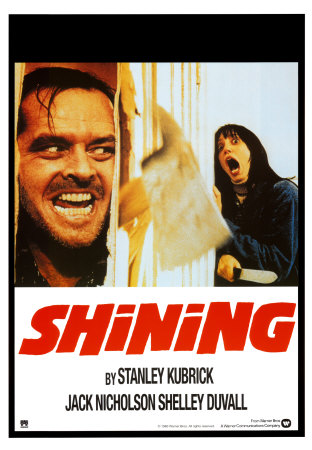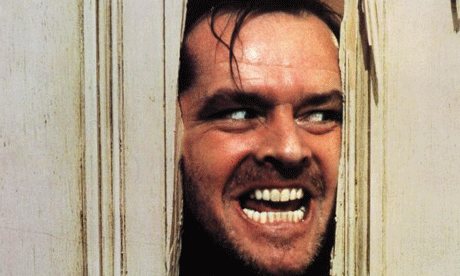Fig. 1. The Shining poster.
The Shining is an adaptation of the Stephen King novel of the same name, in which a family moves into an empty hotel to look after it over the winter. The father, Jack, begins to go mad, either from ‘cabin fever’ or supernatural interference – it is never outright stated which it is, and “the sense of mystery which Kubrick evokes comes in part from his failure to explain exactly what is going on, this allows people to interpret the film in different ways.” (Hill, unknown).
The hotel is visually uncanny – patterns and layouts are repeated constantly, robbing the viewer of visual cues as to location. The building is also somewhat nonsensical – the office of the hotel manager is clearly in the middle of the building, and yet inside there is a window overlooking the grounds. This subtle impossibility sets up the hotel as a place of madness, and implies that perhaps the hotel itself is its source.
Fig. 2. Jack's trustworthy eyebrows.
The hotel also hosts exceedingly tight corridors, creating heavily vertical shot compositions that create a sense of claustrophobia, even in the sprawling hotel. Add to this the fact that, once the snows arrive, the hotel is completely cut off from the rest of the world, and the building feels less like a retreat and more like a prison.
Despite this, the film is surprisingly well-lit. The snow in particular means that, even at night, the bounced light illuminates the scene sufficiently, to the point of feeling ‘wrong’. The snow places light where shadows should be, which, combined with the inherently eerie lighting from below in the climactic chase scene, creates a visual unease.
Fig. 3. Jack peering through door.
Regarding the plot, “Mr. Kubrick tries simultaneously to unfold a story of the occult and a family drama.” (Maslin, 1980). Perhaps it is a ghost story, perhaps an allegory for domestic abuse and the strains of running a household. Both elements resonate throughout the film, with the seeds of Jack’s madness apparently sown long before his arrival at the Overlook.
Illustration List
Kubrick, S. (1980). Fig. 1. The Shining poster. http://cache2.allpostersimages.com/p/LRG/22/2268/RNSZD00Z/posters/the-shining.jpg (Accessed on: 19/01/2012)
Kubrick, S. (1980). Fig. 2. Jack's trustworthy eyebrows. https://blogger.googleusercontent.com/img/b/R29vZ2xl/AVvXsEgnadV_aJ9oDRCk2NEIBXdIgG-D6ewXIRCpRsjRabsJmpP_AhnF5BaKoPUgonRHJOoaDWS4TkI-HSsI4uVpYR_RjcOTFfvrDXJr9SEYA5FDxi_Iz8x1uIEoqWjydf_l8ZcC4vL7uEuJS0s/s1600/Shining+11.png (Accessed on: 19/01/2012)
Kubrick, S. (1980). Fig. 3. Jack peering through door. http://static.guim.co.uk/sys-images/Books/Pix/pictures/2009/01/07/shining460.gif (Accessed on: 19/01/2012)
Bibliography
Hill, S. (unknown). Celluloid Dreams. http://www.celluloiddreams.co.uk/theshining.html (Accessed on: 19/01/2012)
Maslin, J. (1980). The New York Times. http://movies.nytimes.com/movie/review?res=EE05E7DF1738E270BC4B51DFB366838B699EDE (Accessed on: 19/01/2012)




No comments:
Post a Comment